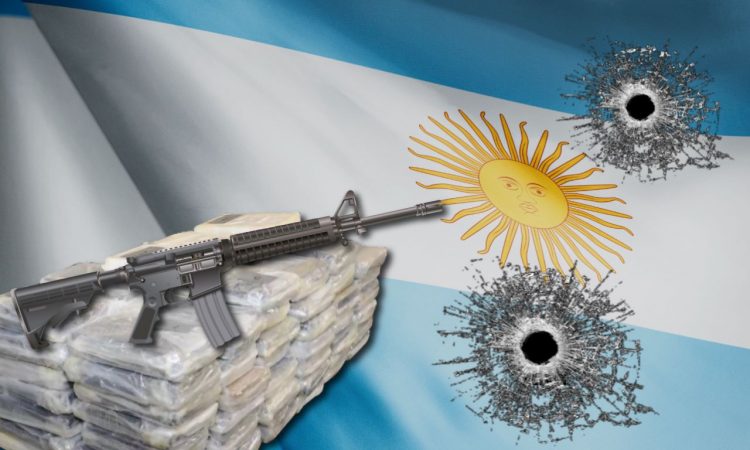Key Findings:
- From January 1 to April 12, 2023, 90 reported homicides occurred in Rosario, Argentina. If this trend continues, annual homicides will reach a record high in 2023.
- The Alberto Fernández administration only started concrete actions against violence in Rosario after a 12-year-old child died in a shooting between two different gangs.
- Rosario residents are constantly expressing their discontent through protests against the insecurity crisis that is endangering their children. Schools have become one of the targets of gang attacks and confrontations.
- The proliferation of dozens of criminal organizations, fighting for territory, appears to be relatively new and exacerbating what was already a noticeable narco presence.
Overview
When the narco presence in Rosario—the country’s third most populated city, located in the Santa Fe province—began is unclear. However, the media started reporting violent events in 2013. One year later, the government began to deploy gendarmerie (Argentine military forces) officers to Rosario for “peace operations” to fight narcos, which included raids of alleged drug traffickers.
Three different administrations have taken office since, but there has been scant response, and narco violence remains rampant. There are 34 known and active narco-gangs in Rosario. In 2016, intelligence officials registered only four.
According to Kirchnerista Congressman Carlos del Frade, the violence spike is due to territorial fights initiated by emerging gangs. From January 1 to April 12, 2023, 90 homicides occurred in Rosario. If this trend prevails, the yearly figure will surpass last year’s all-time record of 287 reported homicide cases.
Some of the most shocking cases of violence include child murders and attacks on public schools. There are at least seven schools across the city that have been shot in the last five years, with injured children the outcome and collateral damage. Further, schools have been receiving threatening messages, as handwritten notes, even though the underlying targets are unrelated to them or their staff. The goal may be media attention to raise their levels of intimidation.
A director of School No. 84 told local media, “Cartels use schools as mailing offices to leave messages to other gangs. They are driving us into something we have nothing to do with.”
On March 5, 12-year-old Máximo Jerez was killed during a shooting between gangs. Jerez was walking on the street with two of his cousins, who were injured due to the gunshots but managed to survive.
Another compelling case, and probably the most echoed by international media, is the shooting of Supermarket Único. It belongs to the parents of Antonela Roccuzzo, wife of world-famous soccer player Lionel Messi. Although no one was injured, police officials revealed: “There is a hand-written letter threatening Messi and his family.”
How Has the Government Responded to Narco Violence?
In a press conference on March 7, in response to the most recent narco-violence cases in Rosario, Argentine President Alberto Fernández announced that the federal government would send at least 400 gendarmerie and federal police officers to Rosario. That was in addition to 1,000 already placed there.
With the deployment of the Armed Forces taking place on March 8, the government fulfilled its goal of reaching 1,400 active officials fighting narcos. Fernández contended that “Rosario needs the country’s support to fight crimes,” but he provided no further details to justify his decision. Fernández also announced the installation of 600 facial-recognition cameras of “cutting-edge technology” to identify criminals.
Mensaje del presidente Alberto Fernández (@alferdez) sobre la situación en la ciudad de Rosario. https://t.co/PLR7VTGPGt
— Casa Rosada (@CasaRosada) March 7, 2023
One week prior to his statement, Fernández said: “We will have to do something about [violence in Rosario].” However, he only initiated action after Jerez’s murder. The president says he wants “criminals to know that the state is present with enough intelligence, strength, and will to jail those who are harming the people.”
The federal government’s 2022 budget allocated 49,350 Argentine pesos per capita for security to the capital city of Buenos Aires. Meanwhile, despite the already-known security crisis in Rosario, Santa Fe province’s security budget consisted of 2,224 pesos per capita in 2022. The country’s most dangerous region received 22 times less per capita security spending than the capital.
How Have Locals Reacted?
In the face of narco violence, citizens have taken to the streets to express their discontent. They are frustrated over the lack of results from the actions of both local and federal governments.
On February 20, for example, over 1,000 Rosario residents went to the Flag Monument—a typical site for demonstrations—to protest. The media and demonstrators dubbed the protest “Rosario Bleeds” (Rosario Sangra). Family members of homicide and robbery victims participated in the demonstration, sharing their experiences, grief, and concerns. There were few concrete proposals on offer, so the objective appeared to simply be heightened awareness and political pressure.
Another example of citizens tired of authorities’ inaction is Antonia Jerez, aunt of murdered Máximo Jerez. She said in an interview on national television: “They [authorities and politicians] will soon forget about us. These police operations against narcos will last two or three months, and everything will return to normal.”
After Jerez’s funeral, his neighbors—tired of violence and drug trafficking—threw rocks at the house of the man who was allegedly responsible for the child’s death. Minutes after the neighbors tried to wreck the house, the police captured all the dwellers—two men and one woman—for preventive detention. Neighbors then invaded and stole many appliances such as refrigerators that were inside the house.
Claudio Brilloni, security minister of the Santa Fe province, recognized: “These riots against the alleged narco’s house show the society is tired of violence and criminal groups. In this case, we faced the assassination of a little kid, who received multiple gunshots.”
Why Violence Ends Up at Schools
Local and school authorities agree that schools are under attack because they are used as message distribution centers between gangs. On the night of April 8, two local schools—No. 84 and 1344—were the target of two shootings. Gangs left threatening messages, declaring war against specific rivals, in the schools.
The Teachers’ Association of the Santa Fe province (AMSAFE) also took to the streets to protest against violence after the two shootings. AMSAFE has asked local and federal authorities such as the Ministries of Education and Security to at least tackle shootings against schools and provide strategies to prevent risks to children and staff.
AMSAFE representatives, alongside childrens’ parents, have proposed the creation of a “safety corridor,” to protect everyone involved in education from violent attacks. They have not, however, made public any further details regarding the idea. Paulo Juncos, AMSAFE’s general secretary, said on national television that he has not received any answer or concrete actions from the government.
Apart from the ongoing shootings of schools, a teacher from School No. 84 asserts that the school now lacks a telephone landline, electricity meter, and water pipes because gangs have stolen them all. She shared that every day she fears going to work and having her students and herself killed.
Narco violence in Rosario, Argentina, has been present for more than a decade. However, it appears that 2023 will break the city’s record for the most homicides in one year. Institutions such as schools are constantly under attack due to the conflict spilling over between multiple gangs. Despite Fernández’s “late actions,” as opposition Congressman Mario Negri has described the government’s latest security plan, there does not appear to be a resolution on the horizon.
 Join us in our mission to foster positive relations between the United States and Latin America through independent journalism.
Join us in our mission to foster positive relations between the United States and Latin America through independent journalism.
As we improve our quality and deepen our coverage, we wish to make the Impunity Observer financially sustainable and reader-oriented. In return, we ask that you show your support in the form of subscriptions.
Non-subscribers can read up to six articles per month. Subscribe here.



